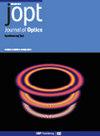基于等离子体元表面的太赫兹偏振传感甲型流感病毒
IF 2.7
4区 物理与天体物理
Q3 OPTICS
引用次数: 0
摘要
太赫兹元表面传感器因其优异的特性而受到广泛关注。然而,现有的传感方案大多忽略了电磁波的极化状态。在此,我们提出了一种基于反射电磁波椭圆偏振态的等离子体元表面传感器,可用于甲型流感病毒的传感。该传感器可在 1-3 太赫兹内实现从线性极化到圆极化的转换。通过分析 1.43 太赫兹和 2.16 太赫兹共振的电磁场分布,可以得出结论:极化转换源于磁偶极子。此外,该传感器还能根据反射波的椭圆极化状态来表征测试样品复折射率的变化。元表面传感器的电磁响应显示,偏振椭圆的旋转方向角与被分析物复折射率的消光系数(k)之间存在良好的线性关系。此外,我们还证明了通过椭圆极化状态在 1.39 THz 频率下检测三种亚型甲型流感病毒(H1N1、H5N2 和 H9N2)的可行性。这种传感方法不依赖于高精度宽带扫描,为太赫兹生物传感提供了另一种视角。本文章由计算机程序翻译,如有差异,请以英文原文为准。
Terahertz polarization sensing for influenza A virus based on plasmonic metasurface
Terahertz metasurface sensors attract extensive attention for excellent characterisics. However, most existing sensing schemes overlooked the polarization state of electromagnetic waves. Here, we propose a plasmonic metasurface sensor based on the elliptical polarization state of reflected EM wave, which can be used for the sensing of influenza A virus. The sensor achieves the conversion from linear polarization to circular polarization within 1–3 THz. By analysing the electromagnetic field distributions of the resonances at 1.43 THz and 2.16 THz, it can be concluded that the polarization conversion originates from the magnetic dipole. Besides, the sensor can characterize the changes in the complex refractive index of the test sample based on the elliptical polarization state of the reflected wave. The electromagnetic response of the metasurface sensor shows an excellent linear relationship between the rotating direction angle of polarization ellipse and the extinction coefficient (k) of the complex RI of the analyte. Furthermore, we also demonstrate the feasibility of detecting three subtypes of Influenza A viruses (H1N1, H5N2, and H9N2) at 1.39 THz though the elliptical polarization state. This sensing approach does not rely on high-precision broadband scanning, providing an alternative perspective for THz biosensing.
求助全文
通过发布文献求助,成功后即可免费获取论文全文。
去求助
来源期刊

Journal of Optics
OPTICS-
CiteScore
4.50
自引率
4.80%
发文量
237
审稿时长
1.9 months
期刊介绍:
Journal of Optics publishes new experimental and theoretical research across all areas of pure and applied optics, both modern and classical. Research areas are categorised as:
Nanophotonics and plasmonics
Metamaterials and structured photonic materials
Quantum photonics
Biophotonics
Light-matter interactions
Nonlinear and ultrafast optics
Propagation, diffraction and scattering
Optical communication
Integrated optics
Photovoltaics and energy harvesting
We discourage incremental advances, purely numerical simulations without any validation, or research without a strong optics advance, e.g. computer algorithms applied to optical and imaging processes, equipment designs or material fabrication.
 求助内容:
求助内容: 应助结果提醒方式:
应助结果提醒方式:


